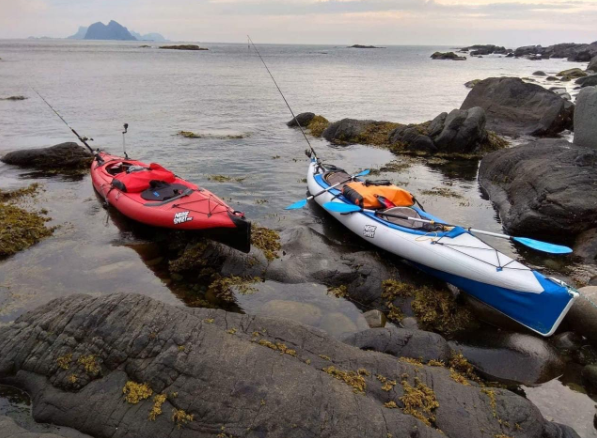
Modern water sports enthusiasts can learn about the ancient origins and radical development of kayaking as an activity. The following list contains ten interesting kayak facts that demonstrate their transition from early practical use into contemporary recreational activities.
If you’re looking for a convenient and versatile way to enjoy kayaking with a partner, the 2 person folding kayak is an excellent choice. This innovative design combines the traditional stability and performance of kayaks with the convenience of portability. Perfect for those with limited storage space or those on the go, a folding kayak can be easily packed up and transported to your favorite water destination.
Table of Contents
1. Ancient Origins
Human civilization has been using kayaks for a minimum timeframe of 4,000 to 5,000 years. The Indigenous Inuit, Yup’ik, and Aleut peoples of Arctic locations built these boats to support hunting activities, river lakes, and ocean travel. Through their specific construction kayak hunters could silently close on their targets for vital survival needs.
2. Traditional Construction Materials
The first designs of kayaks utilized the natural resources found around them. Framing materials originated from floating wood or they substituted whale bones in regions without forests. The frames received animal skin covering in stretched form from seals to form a watertight formation. Traditional Arctic natives demonstrated their skillful use of local resources when they built these watercraft.
3. Etymology of ‘Kayak’
The Greenlandic Inuit language word “qajaq” represents “small boat of skins” from which the modern term “kayak” derived. The naming convention of kayak demonstrates its traditional manufacturing process through animal skin coverings placed over wooden structures. European languages acquired the term from Danish sources because Greenland has constituted part of the Danish royal domain since 1380.
4. Oldest Surviving Kayak
Navgisaaq represents the oldest known kayak which is around 450 years old and currently hosted at the Museum of Five Continents located in Munich Germany. This artifact shows how kayaks were made in ancient times so researchers can analyze early manufacturing practices and the exceptional resilience of these boats along with their masterful construction.
5. Evolution of Materials
Modern kayak manufacturing relies on unique contemporary materials that surpass traditional natural materials used in older kayak fabrication. Fiberglass material strikes a midpoint between weight measurement and strength attributes but it exhibits weak resistance to direct hits. The widespread use of polyethylene plastics in manufacturing occurs because of their strength in impact situations and cost-effective production although they carry significant weight levels. Inflatable kayaks assembled with Hypalon or PVC materials maintain their shape while providing easy portability and rendering them non floodable so boaters can navigate different aquatic terrains.
6. Diverse Designs for Varied Uses
Kayaks have evolved into numerous designs tailored for specific activities:
- Recreational Kayaks: Designed for casual paddling on calm waters, offering stability and ease of use.
- Whitewater Kayaks: Built to navigate rapids, these are shorter and more maneuverable.
- Sea Kayaks: Longer and narrower, designed for open water and efficient long-distance travel.
- Fishing Kayaks: Equipped with features like rod holders and storage compartments, prioritizing stability for anglers.
This specialization allows enthusiasts to choose kayaks that best fit their intended use, enhancing safety and enjoyment.
7. Record-Breaking Distances
The platform of kayaking allows people to achieve outstanding endurance accomplishments. During 2020 South African portage specialist Quinton Rutherford stopped the global record for ocean paddling when he traveled 141.2 miles in 24 hours on the KwaZulu-Natal Sea coast. Human resilience was demonstrated while funds were collected for charitable purposes through this accomplishment.
8. Folding and Inflatable Innovations
Modern scientific developments produced folding and inflatable kayak models which increase portability for users. The collapsible frame of folding kayaks uses wood or aluminum materials which receive protection from durable fabric skins. Kayaks made from strong Hypalon or PVC materials become easily portable by deflation of the inflatable skin. Kayaking technology now supports people who need efficient parking solutions for their kayaking equipment.
9. Pedal-Powered Kayaks
Modern kayaking gained considerable advancement through the invention of pedal controls. Pedal-operated kayaks enable their users to control propulsion through foot-exerted pedal movements that power propellers or fins situated beneath their hulls. People can use this method to maintain their hands-free for fishing or photography tasks since it produces better speed and efficiency compared to manual paddling.
10. Kayaking in the Olympics
Flatwater racing kayaking events marked the first time kayaking appeared at the 1936 Berlin Olympics. Since its Olympic introduction in Berlin in 1936, the sport expanded to add slalom events which demand athletes to pass through gates suspended above water rapids. The growth of competitive kayaking activities thanks to new research has boosted public visibility creating more interest for people to practice kayaking.
The neat boat has revealed considerable changes throughout time from its initial origins as a vital hunting instrument to its contemporary sporting and recreational usage. Various civilizations throughout the millennia have sustained their dependence on these boats because of their valuable design features.